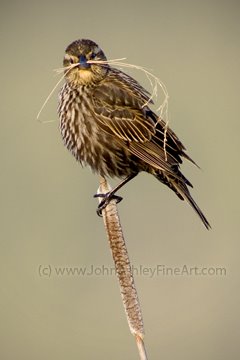Late May already. Hard to believe. The last pile of snow is finally gone from the shady corner of our driveway. Hints of snow still hide in the shadows on the mountainside behind our house, but they’re getting harder and harder to find. As snow gets replaced by birds and flowers, spring is rushing in like a lion.
 Spring is nirvana for a naturalist and photographer, but frustrating at the same time. For every pair of nesting birds we follow, there are 20 more that I want to spend time with. The season has turned into a dawn-to-dusk, seven-day-a-week marathon, and even our dogs are exhausted from all of my running around.
Spring is nirvana for a naturalist and photographer, but frustrating at the same time. For every pair of nesting birds we follow, there are 20 more that I want to spend time with. The season has turned into a dawn-to-dusk, seven-day-a-week marathon, and even our dogs are exhausted from all of my running around.I’m exhausted, and also a bit perplexed. I was raised to believe that the harder you work, the more you will succeed. But sometimes it seems like the harder I try, the more average my work becomes. I ache to be everywhere at once, camera in hand, trying to understand the wild animals and natural phenomenon that surround me. But in springtime I feel constantly rushed, trying to force photos out of the wrong time of day, in the wrong kind of lighting, or during the wrong weather. Even the clouds seem to be rebuffing my efforts.
I’m finally starting to understand how to interpret the cloud cover forecasts. For nighttime astrophotography, I need mostly clear to perfectly clear skies. Otherwise only the brightest stars are visible, and the moon plays hide and seek in the clouds. So when the weatherman forecasts 20% cloud cover between midnight and 6 AM, a reasonable person might expect something close to an 80% clear sky. Wrong. It’s more akin to how the wind blowing east is called a west wind.
We mis-interpreted the 20% overnight cloud forecast a few days ago. Loaded up the car with camping gear, about 50 pounds of camera gear, and the dogs. We drove four hours to position the night sky against the mountains in a pleasing, pre-planned manner. Then we watched the clouds toy with my hopes. Eighty percent clouds at sunset. Down to 60% by midnight – maybe it’ll work out? Nope. Back to 80% by 3 AM, raining by sunrise. No photos whatsoever.
There are better things to do at 3 AM than watch the clouds gather. Sleep, to name just one. But spring is short in Montana, and we can sleep next winter. Time is of the essence, and so we struggle on.
I was heartened recently to read about the struggles faced by some of the top bird photographers out there. It seems that spending half a day crouched in a blind and not getting “the photo” seems to be the norm. The rate of “keepers” is reportedly between 2 and 5 percent, in spite of the advances in camera technology.
Photo blinds always feel cumbersome to me, and I prefer to use stealth and patience. And my few autofocus lenses are always in manual mode because I’m still more accurate than they are. But still, I sometimes spend entire mornings or evenings in my well-worn neoprene waders, feeding the local mosquito populations while sitting in a muddy marsh at the far end of our lake. More often than not, I slog home without an emotionally meaningful photo.
But intermittent reward is more addictive than a reliable reward. (See, I was paying attention in that college psychology class.) And every now and then those muddy hours pay off.
Half an hour after sunset, I started working my way out of the marsh, heading toward the lakeshore and the forested trail that leads home. As I wobbled clumsily across the spongy bog, the resident Loons out in the lake noticed me and swam over to see what this mosquito-clouded creature was all about. I sat down on the rocks at the water’s edge. The Loon pair swam slowly towards me until we could look each other up and down. Eventually, they lost interest in me and my quiet questions. They circled each other twice, rested their heads on their backs, and slept. I mostly just watched, but also took a few photos in the blue twilight, at shutter speeds that they’ll tell you are way too slow for a 500mm lens.

Our quiet meeting didn’t seem to move the Loons much, but I sure enjoyed it. Still, I didn’t have high expectations for photographs taken in the dark without a tripod. But you know what? This time it worked. This time, the blood and mud and struggle turned into something that is timeless. And that is exactly the rare thing that keeps me going.

No comments:
Post a Comment